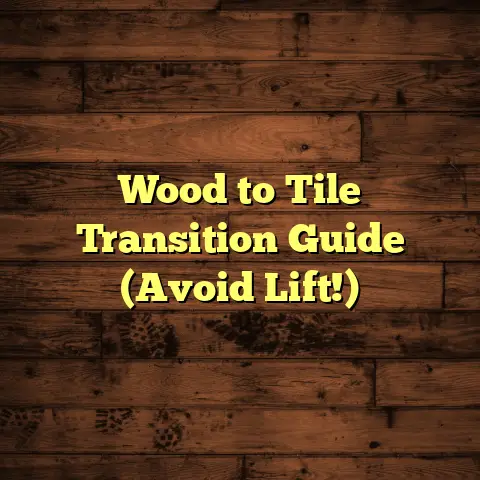Uneven Concrete & Vinyl? (Pro’s Trick!)
Before we dive in, let me crack a little joke to get us started:
Why did the flooring contractor bring a ladder to the job?
Because they heard the job had its ups and downs! 🤣
Alright, jokes aside, let’s get real.
Uneven concrete and vinyl flooring?
It’s a battle I’ve fought countless times in my career, and chances are, you’ve encountered it too.
Whether it’s in your cozy living room or a bustling commercial space, that subtle dip or rise can be a real pain in the… well, you know.
This article is your ultimate guide to tackling this issue head-on. I’m going to share my pro insights on the causes, the impact, and, most importantly, the tricks I’ve learned over the years to resolve it effectively.
So, grab your favorite beverage, settle in, and let’s level up your flooring game!
Section 1: Understanding
Uneven Concrete and
Vinyl Flooring
Definition of Uneven Flooring
What exactly do I mean by “uneven flooring?”
It’s simple: any surface that isn’t perfectly level or smooth.
Think dips, humps, or slopes that you can feel underfoot or see with the naked eye.
Now, let’s talk about concrete and vinyl.
Concrete is a durable, rigid material used as a subfloor or a finished surface. It’s poured and needs to be levelled during the installation process.
Vinyl, on the other hand, is a resilient flooring material that comes in sheets, tiles, or planks.
It’s typically installed over a subfloor, and its flexibility means it can sometimes conform to imperfections beneath it – which can lead to unevenness.
Common Causes of
Uneven Flooring
So, what makes our floors go all wonky?
Here are some of the usual suspects:
-
Poor Installation Techniques: This is a big one. If the concrete wasn’t properly leveled during the initial pour, or if the vinyl wasn’t installed correctly (think improper adhesive application or rushed seaming), you’re setting yourself up for problems down the road.
-
Natural Settling of the Foundation: Over time, all buildings settle. It’s a fact of life. This settling can cause cracks and shifts in the foundation, which then translate to unevenness in the flooring above.
I’ve seen houses where one side has sunk a good inch lower than the other over several decades!
-
Moisture and Environmental Factors: Water is the enemy of pretty much everything in your home, and your floors are no exception.
Excess moisture can cause concrete to swell or crack, and it can wreak havoc on the adhesive holding down your vinyl.
Temperature fluctuations can also cause materials to expand and contract, leading to unevenness.
-
Wear and Tear Over Time: Let’s face it, floors take a beating.
Heavy foot traffic, dropped objects, and just the general passage of time can all contribute to wear and tear that results in uneven surfaces.
Think about that one spot in front of the kitchen sink where everyone stands – chances are, it’s a little lower than the surrounding area.
Impact of Uneven Flooring
Okay, so you’ve got some unevenness.
Is it really that big of a deal?
You bet it is! Here’s why:
-
Aesthetic Issues: Let’s be honest, uneven floors just look bad. They can throw off the entire look of a room and make your home feel dated or poorly maintained.
-
Increased Risk of Accidents: This is a serious one. Uneven floors are a tripping hazard, plain and simple.
Especially for older folks or those with mobility issues, a slight dip or bump can be enough to cause a nasty fall.
According to the CDC, falls are a leading cause of injury and death in the United States, and home environment plays a significant role. (Source: CDC)
-
Damage to Furniture and Appliances: Ever notice how your wobbly table rocks back and forth on an uneven floor?
Over time, that rocking can damage the legs of your furniture.
The same goes for appliances like refrigerators and washing machines.
If they’re not sitting level, they can vibrate excessively and wear out prematurely.
-
Complications During Renovations: Planning a remodel? Uneven floors can throw a major wrench in your plans.
Installing new cabinets, countertops, or even just laying down new flooring can be a nightmare if you’re starting with an uneven surface.
You’ll likely need to address the unevenness before you can move forward, which can add time and expense to your project.
Section 2: Assessing
the Problem
Identifying Uneven Areas
Alright, detective time!
How do you actually find those sneaky uneven spots? Here are a few tips:
-
The Eyeball Test: Sometimes, it’s as simple as looking.
Stand back and scan the floor.
Do you see any obvious dips, humps, or slopes? Are there any areas where the flooring looks discolored or worn?
-
The Feel Test: Walk around barefoot or in socks.
Do you feel any changes in elevation under your feet? Pay attention to areas where the floor feels spongy or unstable.
-
The Level Test: Grab a level (a 4-foot level is ideal) and place it on the floor in various locations.
If the bubble isn’t centered, you’ve got an uneven spot.
Mark the areas with painter’s tape.
-
The Straightedge Test: If you don’t have a level, a long, straight piece of wood or metal will do.
Place it on the floor and look for gaps underneath.
The wider the gap, the more uneven the floor.
Determining the Severity
of the Issue
Not all unevenness is created equal.
Here’s how I classify the severity:
-
Minor: Slight imperfections that are barely noticeable. Think less than 1/8 inch of variation over a few feet.
These might not require immediate attention, but it’s worth keeping an eye on them.
-
Moderate: Noticeable dips or humps that can cause furniture to wobble or create a slight tripping hazard.
We’re talking about 1/8 to 1/4 inch of variation over a few feet.
These should be addressed to prevent further problems.
-
Severe: Significant unevenness that poses a serious tripping hazard or causes major problems with furniture and appliances.
Anything over 1/4 inch of variation is considered severe.
These require immediate attention to ensure safety and prevent further damage.
Documenting the Problem
Before you start tearing things up, it’s a good idea to document the issue.
Here’s what I recommend:
-
Take Photos: Capture the uneven areas from different angles.
Use a ruler or tape measure in the photo to show the extent of the unevenness.
-
Write a Description: Note the location of the uneven areas, their size, and their severity.
Describe any contributing factors, such as moisture or cracks.
-
Create a Diagram: Sketch a simple floor plan and mark the uneven areas.
This will help you keep track of everything when you’re making repairs.
Section 3: Professional Tricks
for Fixing Uneven Flooring
Preparation for Repair
Okay, time to get our hands dirty!
Before you start, gather your supplies.
Here’s a basic list:
-
Safety Gear: Gloves, safety glasses, and a dust mask are essential.
You don’t want to breathe in concrete dust or get chemicals on your skin.
-
Cleaning Supplies: A broom, vacuum, and mop are needed to clean the area before and after repairs.
-
Measuring Tools: A level, straightedge, tape measure, and pencil are crucial for accurate measurements.
-
Repair Materials: Depending on the type of repair, you might need self-leveling compound, concrete patching material, vinyl adhesive, or floor underlayment.
-
Tools: A trowel, putty knife, grinder (with a diamond grinding wheel), and mixing bucket are all useful tools.
Techniques for Repairing
Uneven Concrete
Alright, let’s talk concrete.
Here are my go-to techniques for leveling those bumpy surfaces:
-
Using Self-Leveling Compounds: This is my favorite method for large areas of unevenness.
Self-leveling compound is a liquid mixture that you pour onto the floor.
It spreads out and levels itself, filling in low spots and creating a smooth, even surface.
-
Prep the Surface: Clean the floor thoroughly and apply a concrete primer.
This helps the self-leveling compound bond to the concrete.
-
Mix the Compound: Follow the manufacturer’s instructions carefully.
Too much or too little water can affect the consistency and performance of the compound.
-
Pour and Spread: Pour the compound onto the floor and use a gauge rake or trowel to spread it evenly.
Work quickly, as the compound will start to set within minutes.
-
Let it Cure: Allow the compound to cure completely before walking on it or installing new flooring.
This can take anywhere from 24 to 72 hours, depending on the product.
-
-
Grinding Down High Spots: If you have isolated high spots, you can grind them down using a concrete grinder.
-
Rent a Grinder: You can rent a concrete grinder from most home improvement stores.
Make sure it’s equipped with a diamond grinding wheel.
-
Wear Safety Gear: Grinding concrete creates a lot of dust, so wear a dust mask, safety glasses, and ear protection.
-
Grind Carefully: Start with a low grit grinding wheel and gradually increase the grit as you smooth out the surface.
Avoid grinding too much at once, as this can damage the concrete.
-
-
Filling Low Spots with Patching Materials: For small, isolated low spots, you can use a concrete patching material.
-
Clean the Area: Remove any loose debris and clean the area with a wire brush.
-
Mix the Patching Material: Follow the manufacturer’s instructions.
The consistency should be similar to peanut butter.
-
Apply the Patch: Use a trowel or putty knife to apply the patching material to the low spot.
Smooth it out so it’s level with the surrounding concrete.
-
Let it Cure: Allow the patch to cure completely before walking on it or installing new flooring.
-
Techniques for Repairing
Uneven Vinyl
Now, let’s move on to vinyl.
Here’s how I tackle unevenness under those resilient floors:
-
Lifting and Re-installing Vinyl Tiles: If you have vinyl tiles that are uneven, the best solution is often to lift them and re-install them.
-
Heat the Tiles: Use a heat gun or hair dryer to soften the adhesive.
This will make it easier to lift the tiles without damaging them.
-
Lift the Tiles: Use a putty knife or scraper to gently lift the tiles.
Be careful not to tear or break them.
-
Clean the Subfloor: Remove any old adhesive and clean the subfloor thoroughly.
-
Apply New Adhesive: Use a high-quality vinyl adhesive and apply it evenly to the subfloor.
-
Re-install the Tiles: Press the tiles firmly into place and use a roller to ensure good adhesion.
-
-
Using Floor Underlayment to Create a More Level Surface: If the unevenness is minor, you can often correct it by installing a layer of floor underlayment.
-
Choose the Right Underlayment: Look for an underlayment that is specifically designed for use with vinyl flooring.
Some underlayments are thicker than others, so choose one that will provide the necessary level of correction.
-
Install the Underlayment: Follow the manufacturer’s instructions carefully.
Typically, you’ll need to staple or tape the underlayment to the subfloor.
-
Install the Vinyl Flooring: Once the underlayment is installed, you can install your vinyl flooring over it.
-
-
Applying Adhesive Properly to Prevent Future Unevenness: Proper adhesive application is crucial for preventing future unevenness.
-
Use the Right Adhesive: Choose an adhesive that is specifically designed for the type of vinyl flooring you’re using.
-
Apply the Adhesive Evenly: Use a notched trowel to spread the adhesive evenly over the subfloor.
The notches will help ensure that you apply the correct amount of adhesive.
-
Allow the Adhesive to Tack Up: Before you install the vinyl flooring, allow the adhesive to tack up for the amount of time recommended by the manufacturer.
This will help ensure that the vinyl flooring bonds properly to the subfloor.
-
Finishing Touches
You’ve done the hard work, but don’t forget the finishing touches!
-
Sealing: If you’ve repaired concrete, consider applying a concrete sealer to protect it from moisture and stains.
-
Protecting: Place rugs or mats in high-traffic areas to protect your flooring from wear and tear.
-
Cleaning: Clean your floors regularly to remove dirt and debris.
Use a pH-neutral cleaner that is specifically designed for your type of flooring.
Section 4: Long-Term
Maintenance and Prevention
Regular Inspection
The best way to prevent uneven flooring is to catch problems early.
Inspect your floors regularly for signs of unevenness, cracks, or moisture damage.
Moisture Control
Keep moisture levels in your home under control.
Use a dehumidifier in damp areas, and fix any leaks promptly.
Proper Installation Practices
If you’re installing new flooring, hire a reputable contractor who follows best practices.
Don’t cut corners on installation, as this can lead to problems down the road.
Conclusion
Recap Key Points
We’ve covered a lot of ground in this article.
We’ve talked about the causes of uneven concrete and vinyl flooring, how to assess the problem, and professional tricks for fixing it.
We’ve also discussed the importance of long-term maintenance and prevention.
Encouragement for DIY Enthusiasts
Fixing uneven flooring can be a challenging project, but it’s definitely doable for DIY enthusiasts.
With the right tools, materials, and knowledge, you can level up your floors and create a safer, more beautiful home.
Call to Action
Now, I want to hear from you!
Have you ever dealt with uneven flooring?
What tips and tricks have you learned along the way?
Share your experiences in the comments below!
Let’s learn from each other and make our homes the best they can be.
Happy leveling!





